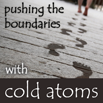Speaker
Prof.
Uwe Fischer
(Seoul National University)
Description
We argue that forcing an interacting quantum many-body
system to reside after a quench far from its equilibrium
state, is an important tool to reveal information on the
correlations in the initial ground state. We discuss two
examples in detail:
[1] We investigate the collapse and revival of first-order
coherence in deep optical lattices when long-range
interactions are turned on and find that the first few
revival peaks are strongly attenuated already for moderate
values of the nearest-neighbor interaction coupling. It is
shown that the conventionally employed Gutzwiller
wavefunction, with only on-site number dependence of the
variational amplitudes, leads to incorrect predictions for
the collapse and revival oscillations within the extended
Bose-Hubbard model. We provide a modified variant of the
Gutzwiller ansatz, reproducing the analytically calculated
time dependence of first-order coherence in the limit of
zero tunneling.
[2] We consider the rapid quench of a one-dimensional
strongly correlated supersolid to a localized density wave
(checkerboard) phase, and calculate the first-order
coherence signal following the quench. It is shown that
unique coherence oscillations between the even and odd
sublattice sites of the checkerboard are created by the
quench, which are absent when the initial state is described
by a Gutzwiller product state. This is a striking
manifestation of the versatility of the far-from-equilbrium
and nonperturbative collapse and revival phenomenon as a
microscope for quantum correlations in complex many-body
states. For the present example, this opens up the
possibility to discriminate experimentally between
mean-field and many-body origins of supersolidity.
Author
Prof.
Uwe Fischer
(Seoul National University)

